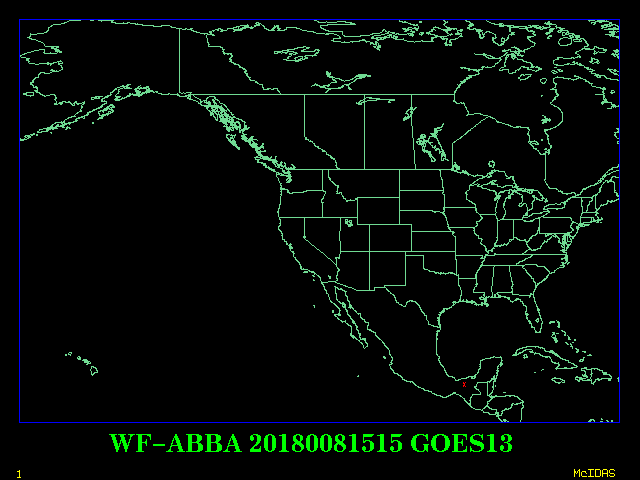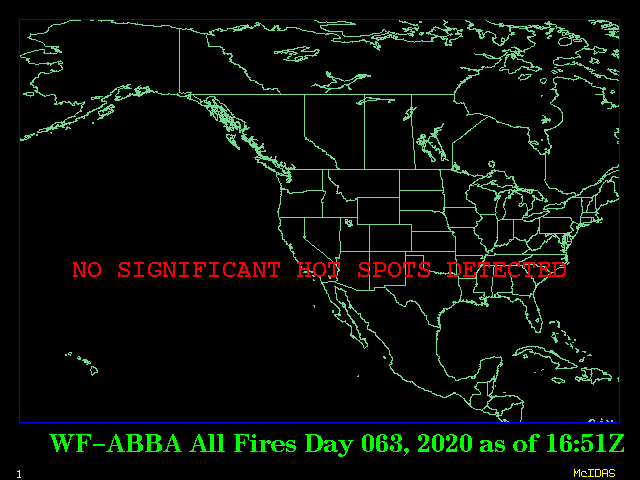The WF-ABBA product was developed by Elaine Prins (NOAA/NESDIS/ORA) in collaboration with the Cooperative Institute for Meteorological Satellite Studies (CIMSS) at the University of Wisconsin. For details about the algorithm, users are referred to the
Biomass Burning Monitoring web page at CIMSS.
The WF-ABBA system runs operationally at the Satellite Services Division. The product is run half-hourly upon receipt of GOES-East or West imagery. The algorithm uses multi-spectral GOES imagery (visible, 3.9 and 10.7 microns).
Users should note:
- This data is generated by an automated algorithm and is placed on the web page in near-realtime. It has not been quality controlled. For a quality controlled product, users are referred to the Hazard Mapping System (HMS) product created by SSD satellite analysts.
- In the raw WF-ABBA product, a large number of false detects were noted around sunrise and sunset due to reflection off clouds. The product available through this site has been filtered against detects noted in the past 12 hours. A new detect is held until it is seen at least twice by either satellite. This has greatly reduced the number of false fires.
- False detects are also noted during summer when surface temperatures can reach extreme values. This problem is worse for GOES-10 (in the west) due to the lower saturation temperature of that instrument. Extra land surface filtering is done in this case.
- Fire locations represent the approximate location of the fire pixel and do not represent the actual fire size. The GOES instantaneous field of view at nadir is 4x4 km, which is quite large, but the fire phenomena is usually much smaller than that. Studies at CIMSS have shown that the minimum detectable fire size at the sub-satellite point, and smoldering at 450K, is approximately .5 to 1 acre in size in relatively non-cloudy conditions. The WF-ABBA is able to identify hot spots through smoke. (Prins and Menzel, 1996).
- GOES data comes in every 15 minutes. Sometimes there are no fires detected. These "empty" files are not placed on the server.
The OSDPD product is a reformatted version of the product available on the CIMSS website. The reformatting of the WF-ABBA product consists of removing the lowest probability fires (category 5), as validation at CIMSS has shown that many of the low possibility fires are not fires. The fields fire size and temperature have been removed as they are very rough estimates of the average instantaneous sub-pixel fire(s) size and temperature, and are not meant to be used for wildfire diagnosis. The header is simplified and the table is put into comma-delimited form so that it can be easily read into a Geographic Information System (GIS) as table data. Each fire is described by a single line, specifying longitude, latitude, 4 micron (channel 2) temperature, 11 micron (channel 4) temperature, ecosystem category, and a fire flag.
The ecosystem category (see table of definitions) is determined by the GLOBAL LAND COVER CHARACTERISTICS DATA BASE.
The fire flag is defined as:
- 0 indicates a processed fire pixel (A fire was identified and conditions were favorable to allow for sub-pixel instataneous estimation of fire size and temperature.)
- 1 indicates a saturated fire pixel
- 2 indicates a cloud-contaminated fire pixel
- 3 indicates a high possibility fire pixel
- 4 indicates a medium possibility fire pixel
- 5 indicates a low possibility fire pixel (at this time, all 5's have been removed to minimize false detects).
The most recent WF-ABBA detects, as well as the other layers that make up the HMS Fire and Smoke Product, can best be viewed through our SSD Fire Web-GIS page.
Download most current fire files (available in ASCII, GIS and graphic formats).
This product is also available via a geospatial archive at the National Geophysical Data Center (NGDC).
Here are plots of the latest GOES-East and West data we have processed and the composite of all the fires so far from today and all the fires from yesterday (both satellites). For the daily plots, the cutoff is 0 GMT (8 pm EDT). The red "X's" are hot spots that are flagged 0-4 and have been temporally filtered (as described above) to minimize false detects.











